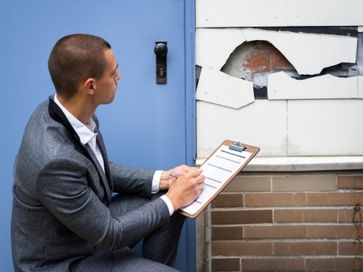A frequently asked question is what do we as appraisers look for when appraising a property? You will find the aspects that influence property valuation. This is helpful as there are plenty of tips so that your property value is higher. Unlike when selling a property, where you want everything to be super clean and tidy, this should not influence the valuation. An appraiser is there to have an independent judgment with an NWWI valuation report. You will not be able to influence most things (at least in the short term).
These are some of the things an appraiser will look out for during the valuation:
Location of the house
The location is often a factor that has a high influence on the value of the house. Is a house in the centre of Amsterdam or is it in Groningen? That will make a big difference in the property valuation. To arrive at a value, an appraiser will look for as many comparable homes as possible near the property to be appraised. So an appraiser will never compare a house in Amsterdam with a house in Groningen.
Total plot area
An appraiser will get the size of the plot from the land registry (in Dutch: Kadaster). Usually, a property consists of 1 plot, but that does not have to be the case. It is also possible that one or more extra plots belong to the house that was bought later. The larger the total plot with a house, the more value it has. With flats, a plot does not apply. Only the size of the garden if there is one (e.g. in the case of ground-floor flats).
Quality of finishing level
The finish level is a very important factor in the valuation. In particular, the appraiser will look at how high-quality, modern, luxurious and tasteful a property is. In the optimal case, a property is finished with good materials (an expensive kitchen can score better than a cheap IKEA kitchen) has not been economised on (think kitchen with all kinds of expensive built-in appliances) and is above all tastefully finished (a very modern kitchen that is pink is not good for the value, because this would probably be replaced).
Efficient housing layout
The property valuer also wants to know whether what he finds inside and around the property makes ‘sense’. It could be that there is a beautiful 110m2 house with four bathrooms. That doesn’t make sense or there is, for example, a house with 4 bedrooms of which 2 bedrooms are so small that they cannot actually be used. Another example is that there are no toilets upstairs at all. So it shows that the appraiser is looking through the eyes of potential buyers of property that needs to be valued. Those potential buyers we call ‘the market’. And how would ‘the market’ now react to how this property is constructed and laid out?
Ownership situation
Is the house and the land on which it stands in full ownership or is it a ground lease? And if it is a ground lease, what are the conditions and costs involved? Sometimes there is also a right of superficies or another right that applies. What we also see a lot is that there is an applicable ground lease that is forever and is also redeemed perpetually. In that case, something like this can be compared to a similar property that is fully owned / on its land. Keep in mind that such ownership cases can be very costly as you have to pay yearly for renting the ground when there is a ground lease.
Outbuildings
Think of outbuildings as garages, sheds, garden sheds, storerooms, etc. If you have 2 more or less similar properties and 1 of those houses has a big garage and the other has nothing of that nature, the property with the garage will of course have a higher property value. This is due to the house’s surface and additional property.
The current state of the house
The maintenance of a property is a very important component in determining the value of the property. When the appraisal is recording the property, the appraiser is required to draw up a building survey state in which each building component is valued for quality. Something can have the following scores:
G – Good
R – Reasonable
M – Mediocre
S – Bad
NO – Further investigation
NW – Unobservable
If an appraiser values a building component (e.g. the gutters, gables, floors, walls, roof, etc) as Mediocre or Bad, the appraiser is required to include an estimation of the repair cost for that component in the report. For example: the roof is Bad and needs to be replaced. The appraiser includes a repair cost of € 40.000 for this. Similarly, the facades all need to be repointed. A cost of € 8.000. The total of these cost items weighs on the appraised value.
However, an appraiser will not climb up the roof with a ladder or crawl into the crawl space to get under the floor. What the appraiser cannot see he will also value ‘Unobservable’. So if an appraiser appraises your house and does not see that the roof is completely rotten and he does not hear this from you, it will not affect the value.
The surface of the house
And of course, there is the living area. In fact, in most cases, this is the most weighty component for the appraised value. The larger the living area, the better it is for the value of the property.
If you have a super large roof terrace and other properties do not, you will score better on the component called ‘building-related outdoor space’ for rating your property.
If you have a larger storage space attached to the house (indoor space) or separate from the house (external storage space), you will score better on these items again.
The Association
For flats, the appraiser looks at the health of the Owners’ Association (in Dutch: VvE). The valuer looks at, among other things:
- Is the association registered with the Chamber of Commerce?
- Does the VvE save money every month in a special VvE bank account?
- Is there a multi-year maintenance plan (in Dutch: MJOP)?
- Is the money the VvE is saving sufficient to meet the budgeted maintenance items from the aforementioned MJOP or are they going to run short of money? If not, this could be a dealbreaker for lenders of potential buyers and the property will be less attractive to buy.
- If there is no MJOP, does the association save at least 0.5% of the rebuild value each year? This is fairly important, as this can be a dealbreaker for lenders of potential buyers and the property is less attractive to buy.
- Is there any overdue maintenance and if so is there enough money in the VvE for this?
Sustainability
The energy label has become incredibly important for buyers. A property with an energy label C will score much better in value on this aspect than one with an energy label G.
Other blogs for appraiser
When to have a porperty valuation
Aspects that influence property valuation
What is a valuation report in the Netherlands?
💡 Need help with finding a suitable appraiser?
We provide you with free help and advice for finding the best and cheapest appraisers.



